Rajasthan Board RBSE Class 11 Biology Chapter 7 Cell Wall and Cell Membrane
RBSE Class 11 Biology Chapter 7 Multiple Choice Objective Questions
Question 1.
Middle Lamella is made up of-
(a) Lignin
(b) Pectin
(c) Pectates of Ca & Mg
(d) Cellulose
Question 2.
The most abundant substance in cell wall is-
(a) Protein
(b) Fat
(c) Carbohydrates
(d) Nucleic acids
Question 3.
Intake of substance by cell membrance is called as-
(a) Cyclosis
(b) Exocytosis
(c) Endocytosis
(d) All the above
Question 4.
One molecule of cellulose consists of-
(a) 3000 glucose molecules
(b) 30,000 glucose molecules
(c) 30,000 fructose molecules
(d) 30,000 galactose molecules
Question 5.
Simple pits are found in-
(a) Sclerenchyma
(b) Collenchyma
(c) Sieve tubes
(d) Tracheids
Answers:
(1) c, (2) c, (3) c, (4)a, (5)c
RBSE Class 11 Biology Chapter 7 Very Short Answer Questions
Question 1.
Who propounded unit membrane concept?
Answer:
Robertson (1958).
Question 2.
Cell wall is made up of what?
Answer:
Polysaccharides (Chitin, cellulose, pectin).
Question 3.
Where the lignin is found in the cell wall?
Answer:
Secondary’ cell wall.
Question 4.
What is the thickness of cell membrane?
Answer:
75A° (70 to 80A°).
Question 5.
What is endocytosis?
Answer:
Intake of substances into the cytoplasm.
RBSE Class 11 Biology Chapter 7 Short Answer Questions
Question 1.
What are pits ? Give their types.
Answer:
Some of the cells (eg parenchyma, sclerenchyma, sieve plates, vessels, trachids cells) remain unthickened. The unthickened parts develop pits which are of two types –
(A) Simple pits – They are found in between the cell wall of adjacent cells of sieve tubes, parenchyma, companion cells etc. These pits are round & cylindrical. They allow the exchange of water and dissolved substances across the membrane. The diameter of simple pits remain uniform and the pit cavity trpens in the lumen of the cell..
(B) Bordered pit – The bordered pits are more complex than the simple pits. In this case, the secondary wall border over the cavity of the pits. Hence, the pit opening become narrow than the pit diameter. In certain cases, the pit aperture are lenticular. The pit membrance of bordered pit develops an oval thickening in the middle. It is called torus. Pit membrane is flexible.
Question 2.
What is plasmodesmata ?
Answer:
Plasmodesmata is a connection between cell walls of two adjacent plant cells.
Question 3.
What do you mean by phagocytosis and pinocytosis.
Answer:
The intake of substance with the help of plasma membrane is called as endocytosis. The intake of solid substance is termed as phagocytosis and the intake of liquid substances is called as pinocytosis.
Question 4.
Explain unit membrane concept of cell membrane.
Answer:
Robertson (1958) propounded unit membrane concept. According to it, one (single) unit membrane consists of three layers (2 proteins +1 phospholipid) and its thickness is 75A° (70 to 80A°).
Question 5.
What are thickenings ?
Answer:
Thickening takes place in the cell wall during formation of secondary wall on the inner side of the primary wall. This type of thickening depends upon the nature of the cell wall. This thickening takes place due to deposition of hard substances such as lignin, cellulose, hemicelluloses, suberin etc.
Question 6.
Give two functions of cell wall.
Answer:
(i) It provides definite shape & size to the cell,
(ii) It provides mechanical support to the cell
Question 7.
Give two functions of cell membrane.
Answer:
(i) It provides shape & size to the cells.
(ii) It protects the cell organelles.
RBSE Class 11 Biology Chapter 7 Essay Type Questions
Question 1.
Explain structure of cell wall. Give suitable diagram.
Answer:
The definite shape of the plant cell is due to its tough covering which is called as cell wall. The nature and composition of the cell wall varies according to its functions . For example, the cell wall in fungi is made up of polysaccharides (Chitin or Fungi cellulose) where as cell wall of algae is made up of cellulose and pectin. The cell wall is of following types –
- Middle lamella
- Primary cell wall
- Secondary cell wall
- Tertiary cell wall
structure of cell wall:
Structurally, it consists of two main parts viz. –
(A) Fibrils & (B) Matrix
(A) Fibrils – They are made up of cellulose. One molecule of cellulose consists of 3000 molecules of glucose. 100 cellulose molecules compile to form a micelle and 20 micelle intum form a microfibril. The 250 microfibrils inturn compile to form one macrofibril having diameter 250A°. The fibrils are absent in primary cell wall but they are found parallel to the secondary cell wall. There is matrix in between the fibrils.
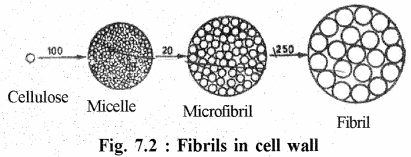
(B) Matrix – It is anon-crystalline & jelly-like substance found in between the primary and secondary cell walls. It consists of water, glycoprotein, pectin and hemi- cellulose. It may also contain gum, resin, tannin, wax and silica.The thick w all of plant cells lacks cellulose layer at many places. Such sites develop minutes pits which are called as primary pits.
The primary pits of adjacent plant cells allow- to form plasmadesmata. The plasma desmata consists of pores or channels between adjacent plant cells walls that allow molecules and communication signals to pass between individual plant cells.There is continuity of the cytoplasm of the adjacent cells through the plasmadesmata i.e. water and low’-molecular- weight solutes can freely diffuse through the plasmadesmata.
This type of cytoplasm is called as symplasm (symplast). On the contrary, the space outside the plasma membrane (inter cellular site) within which material can diffuse freely is called as apoplasm. It is interrupted by the casparian strips in roots, by air spaces between the plant cells & by the plant cuticle.
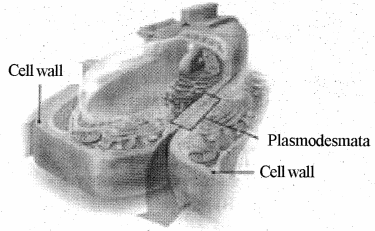
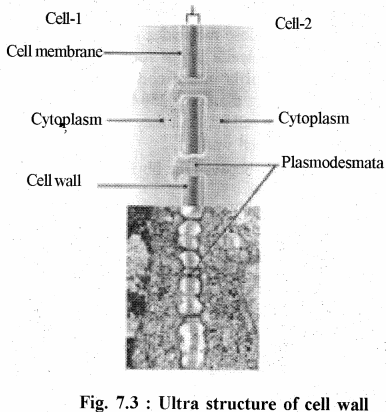
Question 2.
What is fluid-mosaic model ? Explain cell membrane structure in this view.
Answer:
All the cells arc bounded by a thin, elastic, ling, porous,electrically charged and selective semipermeable membranewhich is made up of mainly by proteins & lipids. C. Cramerand Nageli (1855) named this membrane as cellmembrane and Plowe (1931) named it as protoplasm membrane.There are arious thcones to explain the structure of cell membrane.
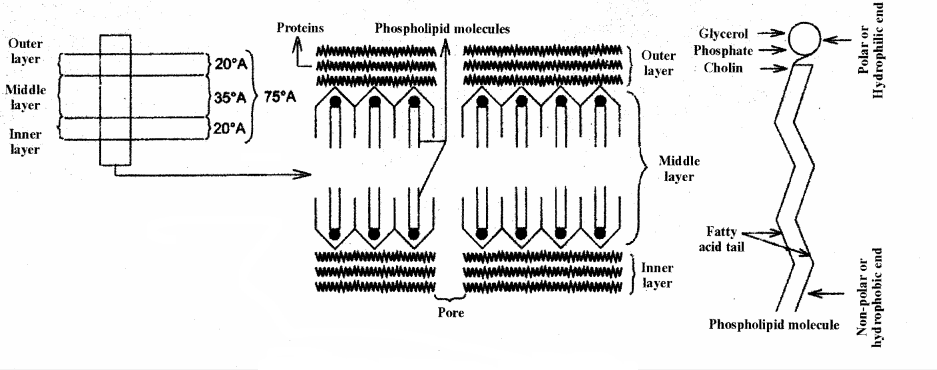 Danielli and Davson (1938) propound sandwich model or Lamellar theory. The model describes a phosphoLipi dbilayer that lies between two lavers of proteins. The thickness of protein lacrs is 20A° (20 to 25A°) and the thickness of middle phospholipid laver is 35A° (30 to 35A°). Hence, the thickness of cell membrane is 75A° (70 to 80A°).
Danielli and Davson (1938) propound sandwich model or Lamellar theory. The model describes a phosphoLipi dbilayer that lies between two lavers of proteins. The thickness of protein lacrs is 20A° (20 to 25A°) and the thickness of middle phospholipid laver is 35A° (30 to 35A°). Hence, the thickness of cell membrane is 75A° (70 to 80A°).
The outer and inner protein layers are hydrophilic. The middle layer consists of two layers of phospholipid molccules. Each phospholipid molecule has a hydrophilic end (polar end) and a hydrophobic end. (non polar end). The hydrophobic ends remain towards centre.
Robertson (1958) propounded unit membrane concept. According to it. one (single) unit membrane consists of three layers (2 proteins + 1 phospholipid) and its thickness is 75A° (70 to 80A°). The mitochondria. plastids and nucleus are bounded by two unit membranes, whereas lysosome. spherosome. vacuoles are bounded by single unit membrane.
S.J. Singer and GL. Nicolsen (1972) propounded Fluid Mosaic model for the plasma menthrane. It is based on the lamellar theory. According to it. the protein layers consist of two types of proteins viz. –
(I) Extrinsic proteins : They remain in the outer & inner layers.
(ii) Intrinsic proteins : They remain embedded into the middle phospholipid layer.
According to this theory. the phospholipid molecules are found in semi fluid phase and the intrinsic proteins exhibit flip-flop movements. The protein layers provide elasticity to the plasma membrane. The phospholipids molecules proide selective semi permeability to the membrane.
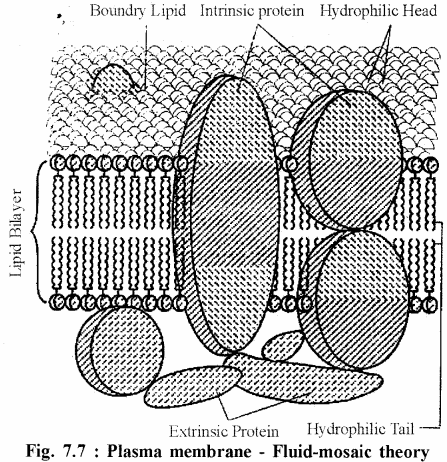
Question 3.
What are thickening. Give an account of various types of thickneings.
Answer:
Thickening takes place in the cell wail during formation of secondary wall on the inner side of the primanry wail, This type of thickening depends upon the nature of the cell wall. This thickening takes place due to deposition of hard substances such as lignin. cellulose, hemicelluloses. suberin etc. The thickening is found in the cells of certain parts like pericycle, phloem. xylem etc.
Some of the cells (cg parenchvina, sclerenchvma. sieve plates, vessels. trachids cells) remain unthickened. The unthickened parts develop pits which are of two types –
- Simple pits – The are found in between the cell wall of adjacent cells of sieve tubes, parenchyma. companion cells etc. These pits arc round & cylindrical. They allow the exchange of water and dissolved substances across the membrane, The diameter of simple pits remain uniform and the pit cavity trpens in the lumen of the cell.
- Bordered pit – The bordered pits are more complex than the simple pits. In this case. the secondar’ wall border over the cavity of the pits. Hence, the pit opening become narrow than the pit diameter. In certain cases, the pit aperture are lenticular The pit membrance of bordered pit develops an oval thickening in the middle. It is called torus. Pit membrane is flexible.
The liquid in cell put pressure on the pit membrane and the pit membrane pushes the torus. Thus the toruse closes the bordered pit. Hence, it acts as a valve.These are found in the vessles, tracheids and fibres of xylem.
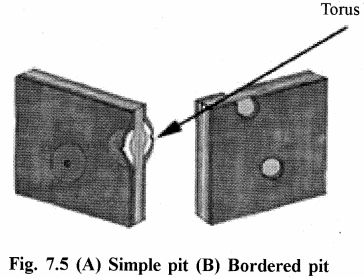
Question 4.
Explain various functions of cell membrane.
Answer:
Modifications of plasma membrane:
In animal cells, the plasma membrane forms certain structures to perform special functions which are as follows –
(i) The epithelial cells form finger – like processes called microvilli to provide increase surface for absorption.
(ii) It forms desmosomes between adjacent cells that consists of tono fibrils.
(iii) In some cells, it forms interdigitations.
Functions of Plasma Membrane:
- It provides shape & size to the cells.
- It protects the cell organelles.
- It performs transportation of the substances which is of two types-
- Passive transport – It involves movement of the substances from their high to low concentration. It does not require energy.
Example – Diffusion, Osmosis. - Active transport – It involves movement of the substances against concentration gradient i.e. from low to high concentration. It takes place at the cost of energy (ATP). In this process carrier proteins (Permeases) act as carrier.
- Passive transport – It involves movement of the substances from their high to low concentration. It does not require energy.
- It helps in cell adhesion.
- It bears respiratory enzymes in prokaryotes (e.g. bacteria)
- It performs endocytosis. The intake of substance with the help of plasma membrane is called as endocytosis. The intake of solid substance is termed as phagocytosis and the intake of liquid substances is called as pinocytosis.
(vii) It performs exocytosis (expulsion of waste products from the cell).